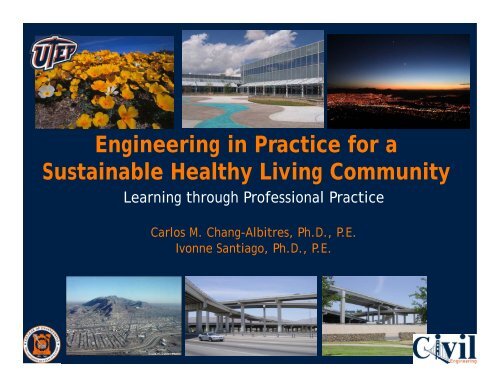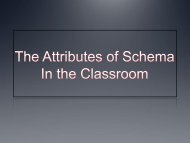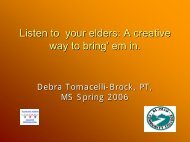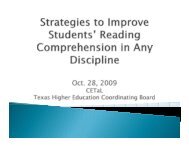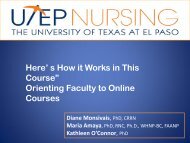HERE - CETaL - University of Texas at El Paso
HERE - CETaL - University of Texas at El Paso
HERE - CETaL - University of Texas at El Paso
You also want an ePaper? Increase the reach of your titles
YUMPU automatically turns print PDFs into web optimized ePapers that Google loves.
Engineering in Practice for aSustainable Healthy Living CommunityLearning through Pr<strong>of</strong>essional PracticeCarlos M. Chang-Albitres, Ph.D., P.E.Ivonne Santiago, Ph.D., P.E.
About the Program• Engineering in practice is a program hosted by theCollege <strong>of</strong> Engineering <strong>at</strong> the <strong>University</strong> <strong>of</strong> <strong>Texas</strong> <strong>at</strong> <strong>El</strong><strong>Paso</strong> (UTEP) to foster best engineering practices.• The pilot program began <strong>at</strong> the Department <strong>of</strong> CivilEngineering Fall 2010.• Supports activities both <strong>at</strong> the undergradu<strong>at</strong>e andgradu<strong>at</strong>e level th<strong>at</strong> connect pr<strong>of</strong>essional practice andeduc<strong>at</strong>ion.
Why this Program?• The need <strong>of</strong> having engineers who are aware <strong>of</strong>on-going changes in the economic, social, andenvironmental conditions has increased in a worldth<strong>at</strong> is constantly evolving.• Address multidisciplinary engineering challenges.Engineering in practice = Engineering in service
Other Objectives• To merge educ<strong>at</strong>ion, research, and pr<strong>of</strong>essionalpractice with a team composed <strong>of</strong> faculty, gradu<strong>at</strong>eand undergradu<strong>at</strong>e students to work with pr<strong>of</strong>essionalengineers.• To propose solutions to engineering problems th<strong>at</strong>pose a thre<strong>at</strong> for a healthy living community.
Expected Outcomes• To transfer pr<strong>of</strong>essional knowledge accumul<strong>at</strong>edthrough years <strong>of</strong> practice to the students.• To increase student’s awareness th<strong>at</strong>engineering problems need to be understoodunder their own decision-making context.
How to Join the Program?• Students should identify an expert group <strong>of</strong>interest and contact the coordin<strong>at</strong>or to look fortopics.• Faculty members interested in developing orjoining an expert group.• Pr<strong>of</strong>essional engineers who have identified aspecific problem <strong>of</strong> interest can contact the expertgroup coordin<strong>at</strong>or to join the program.
Expert Groups• Expert groups will addressdifferent types <strong>of</strong>engineering challenges for asustainable healthy livingcommunity.• The expert group will includeundergradu<strong>at</strong>e and gradu<strong>at</strong>estudents, faculty members,and pr<strong>of</strong>essional engineersfrom sponsor organiz<strong>at</strong>ions.• Construction Techniques• EnvironmentalEngineering• Infrastructure• Innov<strong>at</strong>ive M<strong>at</strong>erials• Pavements• Transport<strong>at</strong>ion Systems• W<strong>at</strong>er ProcessingSystems (Desalin<strong>at</strong>ion,others)
Courses• Undergradu<strong>at</strong>e and gradu<strong>at</strong>e students who are takingthese courses, but not limited to, will be eligible toparticip<strong>at</strong>e in the program.Undergradu<strong>at</strong>e program:• CE 1205 Graphic Fundamentalsin Engineering Design• CE 2341 Economics for Engineersand Scientists• CE 3313 Engineering Measurements*• CE 3336 Engineering M<strong>at</strong>erials• CE 4188 Senior Design I*• CE 4288 Senior Design II*Gradu<strong>at</strong>e curricula:• CE 6195 Civil Engineering Seminar *• CE 6301 Infrastructure Management*• CE 6315 Infrastructure Planning• CE 5324 Construction Management• CE 5310 Risk and Reliability Analysis<strong>of</strong> Engineering Systems* These classes particip<strong>at</strong>ed in EIP in 2011 and 2012
ActivitiesNovember 2012October 2011Roadway Safety by ARTBAApril 2011Asset Management by AgileAssetsFebruary 2011Forgiving Highways by Barrier SystemsBorder Environment Cooper<strong>at</strong>ionCommission Plans and Projects
NCEES Engineering Award• In 2009, NCEES introduced this award torecognize college engineering programs forengaging their students in collabor<strong>at</strong>iveprojects with licensed pr<strong>of</strong>essional engineers.• The NCEES Engineering Award forConnecting Pr<strong>of</strong>essional Practice andEduc<strong>at</strong>ion was established to promoteunderstanding <strong>of</strong> the value <strong>of</strong> licensure and toencourage partnerships between theengineering pr<strong>of</strong>ession and educ<strong>at</strong>ion.
NCEES Awarded Projects• “Development <strong>of</strong> a Sustainable InfrastructureManagement System for the City <strong>of</strong> <strong>El</strong> <strong>Paso</strong>”• “Multidisciplinary Smart Design <strong>of</strong> Fire St<strong>at</strong>ion513”.
2011 and 2012 NCEES Awards20112012
NCEES 2011 AWARD
NCEES 2012 AWARD
Multidisciplinary Smart Design <strong>of</strong> Fire St<strong>at</strong>ion 513Civil Engineering Senior Design Project
Goal• Give the students a real world first-handknowledge <strong>of</strong> how the engineering designworks in a client/consultant environment.
General Description• The design problem was defined in collabor<strong>at</strong>ionwith partners from City government and faculty• Senior Design Capstone Course: One Year/3credit/two Semester project
Minimum Requirements: 1 st Semester• Mentor: Architect• Review Codes and Regul<strong>at</strong>ions• Become familiar with required permitting• Conceptual Design• Floor plan (with dimensions)• Site plan
Conceptual Design
Minimum Requirements• Environmental• Geotechnical• Structural• Construction Management• Transport<strong>at</strong>ion
Environmental Design• LEED• 52 points (loc<strong>at</strong>ion, stormw<strong>at</strong>er management plan,landscaping, and use <strong>of</strong>sustainable m<strong>at</strong>erials,among others).• Surface run <strong>of</strong>f• shallow channels linedwith river rocks leading toseveral smaller decor<strong>at</strong>iveponds.
Geotechnical• Geo-tech analysis• Found<strong>at</strong>ion Design
Structural• Complete structure (beams, columns) andchecks for stresses and deflections
Construction Management• Cost Estim<strong>at</strong>e, schedule for design andconstruction (pre, during, and after)
Transport<strong>at</strong>ion• Traffic flow, curves, parking
Knowledge and skills gained
Student’s Feedback• Biggest challenge faced in the project or EIP programand how it was overcome• R<strong>at</strong>e the EIP program objectives• Knowledge <strong>of</strong> pr<strong>of</strong>essional practice acquired• Knowledge <strong>of</strong> pr<strong>of</strong>essional code <strong>of</strong> ethics• Learn to make an effective oral present<strong>at</strong>ion• Work effectively as a team/group member• Did the EIP program on project experience help youto be prepared to get a job?• Mention the areas th<strong>at</strong> you feel are most important t<strong>of</strong>ocus on the program• Mention wh<strong>at</strong> positive experiences you had by beingpart <strong>of</strong> the project/EIP program
Conclusions• Students are exposed to pr<strong>of</strong>essional practice and researchtechniques and challenged to use all their cre<strong>at</strong>ivity to comeout with practical solutions to real world problems.• Allowed students to learn and develop skills not capable <strong>of</strong>being taught in a classroom:• Pr<strong>of</strong>essional practice and responsibility, leadership, timemanagement, teamwork, and compromise• Faculty members are able to show students the applic<strong>at</strong>ion <strong>of</strong>topics lectured in class and demonstr<strong>at</strong>e how research can beused to develop practical solutions.


